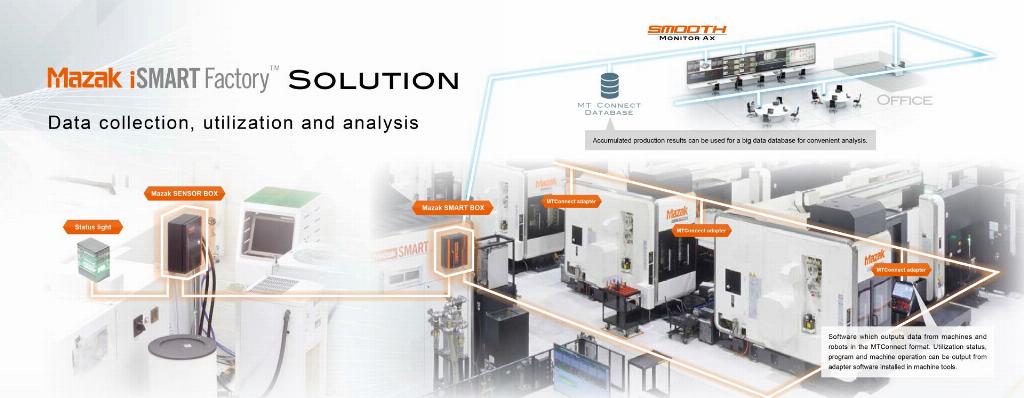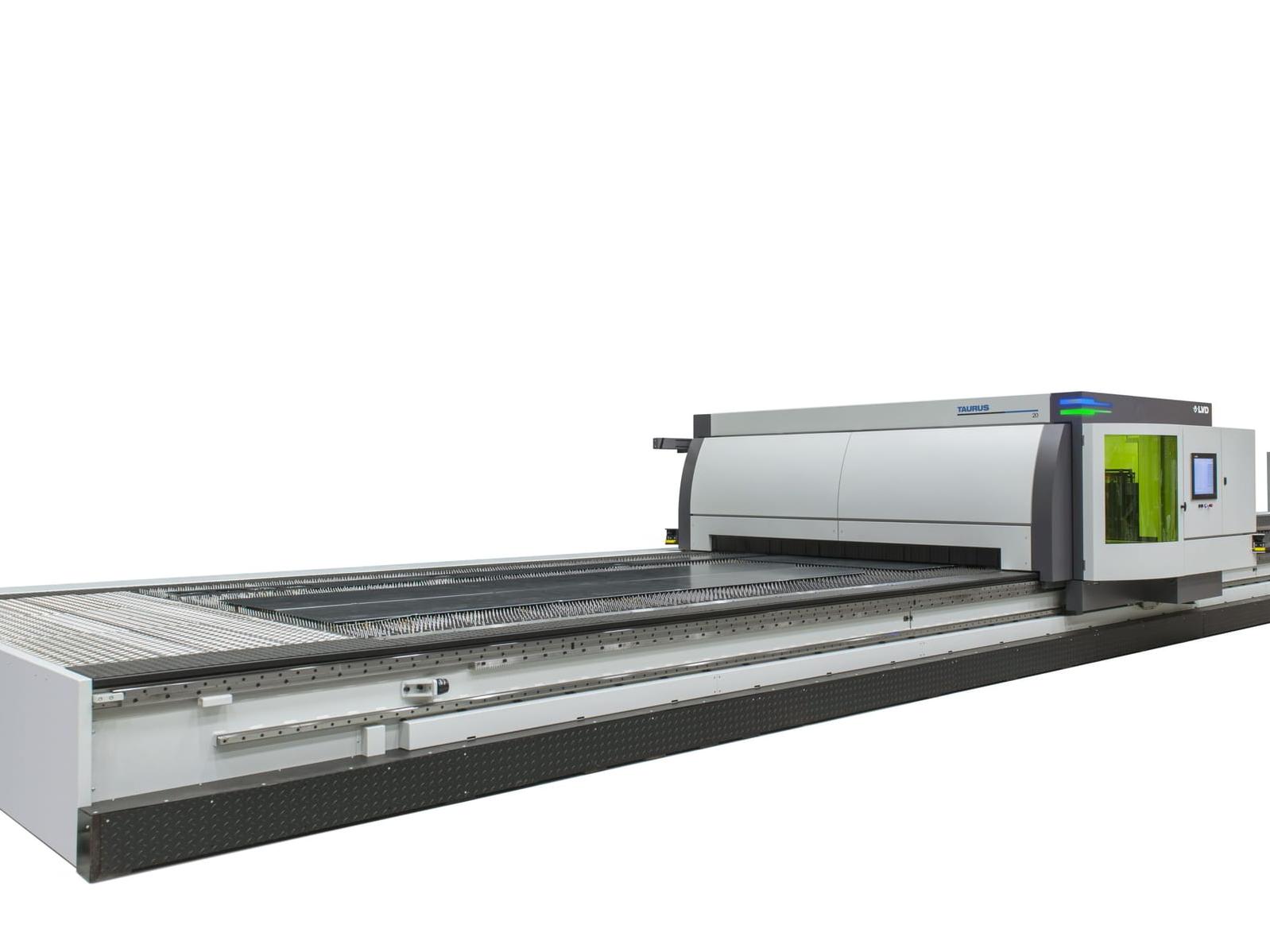JANUARY COVER STORY: Industrial revolution

EMO 2017 in Hannover may be a distant memory but the show’s legacy is very much alive and well because this was the exhibition where Industry 4.0 got real. One company that is well ahead of the curve is Yamazaki Mazak. Dave Tudor caught up with one of its product managers, Mark Hall for a discussion about data driven manufacturing.
You’ll see Industry 4.0 labelled in various ways – the Internet of Things, Big Data, the Fourth Industrial Revolution – but as an understandable definition, I quite like Bryce Barnes, Cisco’s senior manager, machine and robot segment’s take on things:
“It is the intelligent connectivity of smart devices by which objects can sense one another and communicate, thus changing how, where and by whom, decisions about our physical world are made. This universal industrial network will be open, secure and extensible. It will be built around open software architecture, open protocols and open data models.”
Where we are today may seem revolutionary, but in fact it’s more evolutionary. The first industrial revolution saw the advent of mechanisation, steam and water power – the first mechanical loom dates back to 1784. The second industrial revolution introduced mass production, assembly lines and electricity; the third, computers and automation – the first programmable logic controller (PLC) dates back to 1969.

All of these steps lead to where we are today – the fourth industrial revolution – which heralds the arrival of cyber-physical systems, explained so eloquently by Mr Barnes above. This is the age of the digital factory and digital manufacturing – or in Mazak’s case, the iSMART Factory.
“This is our vision within Mazak which takes the Industry 4.0 concept into reality and implementation,” Mark Hall explains. “It’s centred around a continuously evolving factory with its foundations built upon a highly digitalised and automated manufacturing system.
“Our objective is to provide value to customers using our products and services via daily production and productivity improvements. In an iSMART Factory, nothing stays the same – process improvements may be incrementally large or small – but everything is constantly evolving.”
Walking the walk
You could never accuse Mazak of ‘talking the talk’ and not ‘walking the walk’. It has embarked on a global program that has seen iSMART Factory principles implemented throughout its own manufacturing plants worldwide.
“We use our machine tools to make our machine tools,” Mr Hall states. “This means that the knowledge and data we harvest from our own manufacturing processes is recycled and used to produce better machines and systems – and ultimately greater productivity – for our customers. Additionally, as we’re able to manufacture machines much more efficiently, this will have a positive effect on lead-times”
Mazak has 10 manufacturing plants worldwide and iSMART Factory implementation began with the Oguchi facility in Japan. Now, programs are well underway at its Kentucky and Worcester plants. “It’s very much an ongoing process, Mr Hall reveals. “At Oguchi, we’re collecting more than 12 million individual samples of machine data every day – that’s a phenomenal amount of information that we can use to improve our products and systems.”
Smooth operator
Data collection from machine tools is nothing new, but this is a different ballgame entirely. Mr Hall believes that the ultimate goal is to use the data acquired to develop Artificial Intelligence (AI)-based products and systems, and then apply them in an autonomous manner to a self-evolving automated factory.
There are two main drivers behind Mazak’s Industry 4.0 initiatives: the iSMART Factory and its Smooth technology.
When Smooth technology was first introduced by Mazak in 2014, it was claimed by the manufacturer to be the world’s fastest CNC. With its intuitive touchscreen interface and reported 30% reduction in cycle times (SmoothX 5-axis), it was originally implemented for single cell (machine) operation.
Now however, it is pivotal to the iSMART Factory concept, linking the office to the shopfloor, and that’s the crucial part. There are machine-centric modules like Smooth Gear Cutting, Smooth Energy Dashboard, Smooth Spindle Analytics and Smooth Machining Configuration, but it’s important to look at things holistically in this context. Smooth modules effectively bind everything together: machines, automation and factory management.
With this holistic view in mind, the Smooth Monitor AX module ensures that operational results of each machine can be accessed by all relevant people, using a LAN connection. It graphically represents the status of each machine and offers an overall visualisation of factory status. Dashboards can be displayed in the factory or monitored via a smartphone or other mobile device with key information, such as spindle load, available for analysis at all times.

Importantly, this technology is not only applicable to Mazak equipment, but also products from other manufacturers as well. Smooth Monitor AX uses MTConnect, an open, royalty-free manufacturing communications protocol that has the ability to connect different machines and automation systems on the factory floor, enabling third party suppliers of equipment to interface with CNC systems, such as Mazatrol Smooth.
“Consider a practical example,” Mr Hall says. “A company’s machine inventory may include Mazak machine tools, laser cutting technology and Mazak legacy equipment, but the chances are that there will be a number of machines from a variety of other manufacturers as well.
“Some of the Industry 4.0 concepts you see in the marketplace are based around the purchase of brand new equipment from a specific manufacturer. I think that’s totally unrealistic – not to mention probably unachievable economically and practically. What’s more likely, in a typical manufacturing company, is that there’ll be disparate machinery of different ages, origins and brands. Mazak for example don’t manufacture grinding machines but many of our customers have them. An iSMART Factory has to be able to incorporate and connect all these elements seamlessly.”
Working together
So how does the iSMART Factory address these challenges? Well, Mazak has developed a number of technologies to make this happen: the Mazak SmartBox; Smooth Monitor AX (mentioned above); and the development of an MTConnect database in conjunction with the MTConnect protocol.
The database is where all the ‘big data’ will reside (12 million data samples a day in Mazak Oguchi’s case); it’ll be large, long-term and the subject of extensive analysis. It’s of paramount importance too as it will undoubtedly directly influence decisions made about future machine and equipment development.
The MTConnect protocol is the ‘glue’ that binds everything together, because it allows information coming from a Mazak machine and a competitor’s machine to be translated into the same format. It’s based on XML and HTTP technology and it means that third party software writers can develop programs that take standardised information from any machine tool – irrespective of manufacturer.
Let’s think about that for a minute because this is game changing. Previously machine tool manufacturers would write proprietary software that would only work with their machines. Now, the ability to work with disparate equipment is a prerequisite for any Industry 4.0 based factory. Times they are a changing!
Smart Boxes for smart businesses
Continuing with the iSMART Factory shopping list, the Mazak SmartBox is a convenient and highly secure network interface that acts in a similar manner to a sophisticated, high-end hardware firewall, facilitating efficient – and secure – data sharing and networking.
“At its heart, the Mazak SmartBox is a Cisco Level 3 managed switch,” Mr Hall explains. “It’s a cost-effective and maintenance-free solution that provides a logical separation between the shopfloor and the office areas so that only necessary data is allowed through, collected and analysed.
“It collects MTConnect data from not only advanced Mazak machines equipped with Mazatrol Smooth CNC, but also previous models with Matrix and Fusion controls and other manufacturers' equipment. It also transfers machining programs and NC backup data between office and factory, eliminating the security risk associated with using USB flash memory.”
When you think about it, in terms of logical separation, the Mazak SmartBox makes sense. Whilst the free flow of data internally between areas within a company is a good thing and essential to an Industry 4.0 set-up, there has to be some control to prevent superfluous data getting through to the point of saturation. It will also prevent the transfer of viruses up and down the network and minimise the risk of hacking, even for older operating platforms which anti-virus software is now ineffective at protecting.

Legacy machines present other challenges as Mr Hall affirms: “It’s quite simple to fit an MTConnect adaptor onto any machine that uses a Windows-based operating system but we have machines – still working well – in the field that are 25-30 years old.
“It’s quite feasible that the customer would want to integrate these machines into a connected environment and extract data for analysis. We’ve provided a solution for this scenario with our Mazak Sensor Box which will take data from a legacy machine and convert it into an MTConnect format.”
Small companies, big thinking
At the moment, to a small subcontractor in Barnsley, Birmingham or Bolton, working flat out to make ends meet, Industry 4.0 might seem like a lofty aspiration, aimed at those larger manufacturers with the time, money and inclination to implement it. Mark Hall however would disagree.
“Many of Mazak’s customers are SMEs and it’s a hugely important market for us,” he emphasises. “SMEs generally run very lean, and I believe that the ability to really understand how efficiently machine tools and other equipment are being used is invaluable – especially when companies are often short-staffed, or perhaps simply can’t find the level of skills required.
“With the right data at your disposal, short- and long-term capacity issues can be addressed methodically, processes can be optimised, maintenance programs can be properly planned rather than when something breaks down and vital data like spindle analytics and machine energy consumption can accessed and analysed. Companies will be able to predict when to change a machine bearing before it actually fails. It’s all about working smarter.”
Yamazaki Mazak www.mazakeu.co.uk














